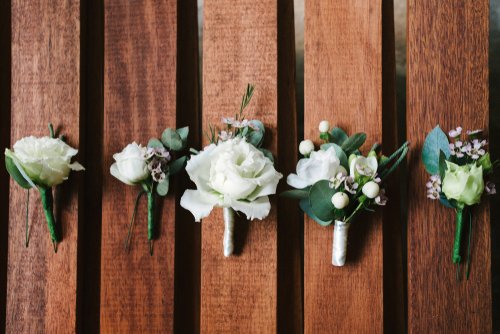Boutonniere 101: What It Is and How To Wear It

Most wedding attire follows a few basic rules. The rest falls to inspiration, personal style, and budget. If you’re planning on wearing a suit or tux on your big day, you’ve got many options for customizing your look. The flowers in your boutonniere may eventually wilt, but this oft-misunderstood accessory can add memorable touches to your ensemble. This guide offers a crash course on the boutonniere. You’ll learn about the basics, plus how to choose and wear one on your big day.
A Quick History of the Boutonniere
As you may have guessed, “boutonniere” is a French word. Its origins are rather straightforward – the Online Etymology Dictionary says that it first appeared around 1875 and came from “bouton,” which means “button.” The term refers to a single flower or a small spray of flowers worn inside a buttonhole.
No one’s clear on exactly how the custom of wearing boutonnieres developed. He Spoke Style mentions that soldiers may have first donned them on English battlefields to tell comrades from enemies. Frock coats became popular during the 19th century, including high-collared versions that buttoned up the neck. When they were worn with the top buttons open, the empty buttonholes were perfect for holding a small flower.
Once fashionable gents adopted the trend, it stuck. If you notice photographs of men from the early 1900s, you’ll see they wore suits most of the time. This was especially true for businessmen, who adopted morning coats as part of their everyday dress. And boutonnieres remained the accessory du jour with those coats. But as fashion changed, men mostly reserved them for formal attire.
Boutonnieres in the 21st Century
Today’s suit and tuxedo coats do not have buttonholes on their lapels. Wedding Wire’s Kim Forrest explains that a boutonniere is pinned onto a jacket’s left lapel, positioned over the heart. If you are not wearing a jacket, you can fasten it to a suspender, vest, or even directly onto your dress shirt.
Besides that, there aren’t many rules about wearing boutonnieres. For weddings, they usually include the same types of flowers that appear in other arrangements. They also tend to use the same colors. And as for who should wear one, that is also simple – anyone who is immediate family or in the wedding party and plans on donning a suit.
Helpful Tips for Your Boutonnieres
With a simple structure and a few guidelines, you have lots of options for styling your boutonniere. You’ll want to choose flowers and greenery that will hold up for several hours. That means hardier varieties – Forrest mentions succulents, roses, and orchids as a few examples. Other optimal choices, according to Flower Duet, include carnations, chrysanthemum, and small calla lilies. Your florist can offer more extensive guidance.
Boutonnieres typically include flowers, but you don’t have to limit yourself to blooms alone. Harmonizing them with your wedding arrangements is vital. Even if you are only using greenery for décor and wedding party bouquets, your boutonnieres can complement them perfectly. A bundle of fresh herbs delights both visual and olfactory senses. Small berries with greenery are also lovely alternatives. If you want to go further off the beaten path, Samantha Iacia suggests miniature fruit and even feathers. There are many more possibilities – you can explore these with your florist to find something that appeals to your style.
Expressing Your Personal Style
Your wedding day offers many opportunities for creative expression. Your boutonniere is only one accessory, but you can do a lot to create its individual look. Flowers, greenery, fruit, and decorative accessories provide a world of opportunities. Teaming up with your pros, especially your florist, can help you design a standout wedding boutonniere.














